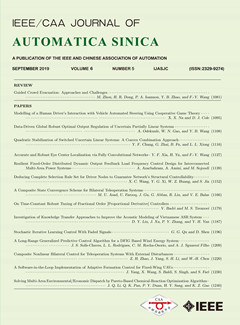 Volume 6
Issue 5
Volume 6
Issue 5
IEEE/CAA Journal of Automatica Sinica
| Citation: | Xiaogang Wang, Xiyu Liu and Yu Li, "An Incremental Model Transfer Method for Complex Process Fault Diagnosis," IEEE/CAA J. Autom. Sinica, vol. 6, no. 5, pp. 1268-1280, Sept. 2019. doi: 10.1109/JAS.2019.1911618 |

| [1] |
W. C. Sang, H. P. Jin, and I. B. Lee, "Process monitoring using a gaussian mixture model via principal component analysis and discriminant analysis, " Computers & Chemical Engineering, vol. 28, no. 8, pp. 1377-1387, 2004. http://www.wanfangdata.com.cn/details/detail.do?_type=perio&id=65dba41b16cab1ad18e6181b8673da19
|
| [2] |
V. Venkatasubramanian, R. Rengaswamy, K. Yin, and S. N. Kavuri, "A review of process fault detection and diagnosis: part Ⅰ: quantitative model-based methods, " Computers & Chemical Engineering, vol. 27, no. 3, pp. 293-311, 2003. http://d.old.wanfangdata.com.cn/OAPaper/oai_doaj-articles_672e437ca64c6970ffd6c1d01ad2d258
|
| [3] |
C. Tong and X. Yan, "Statistical process monitoring based on a multimanifold projection algorithm, " Chemometrics & Intelligent Laboratory Systems, vol. 130, no. 2, pp. 20-28, 2014.
|
| [4] |
X. Wang, H. Feng, and Y. Fan, "Fault detection and classification for complex processes using semi-supervised learning algorithm, " Chemometrics & Intelligent Laboratory Systems, vol. 149, pp. 24-32, 2015. http://www.wanfangdata.com.cn/details/detail.do?_type=perio&id=82ca5a4ad55c1a1329b652f15d109671
|
| [5] |
H. V. Khang, R. Puche-Panadero, J. S. L. Senanayaka, and K. G. Robbersmyr, "Bearing fault detection of gear-box drive train using active filters, " in Proc. Int. Conf. on Electrical Machines & Systems, 2016.
|
| [6] |
D. Aguado and C. Rosen, "Multivariate statistical monitoring of continuous wastewater treatment plants, " Engineering Applications of Artificial Intelligence, vol. 21, no. 7, pp. 1080-1091, 2008. doi: 10.1016/j.engappai.2007.08.004
|
| [7] |
Y. Hu, H. Ma, and H. Shi, "Local model based kpls with application to fault detection of batch process, " in Proc. Control and Decision Conf., 2013, pp. 1097-1103.
|
| [8] |
K. H. Hui, H. L. Meng, M. S. Leong, and S. M. Al-Obaidi, "Dempstershafer evidence theory for multi-bearing faults diagnosis, " Engineering Applications of Artificial Intelligence, vol. 57, pp. 160-170, 2017. doi: 10.1016/j.engappai.2016.10.017
|
| [9] |
K. H. Sorsa T, Koivo H N, "Neural networks in process fault diagnosis, " IEEE Transactions Systems Man & Cybernetics, vol. 21, no. 4, pp. 815-825, 1991. http://d.old.wanfangdata.com.cn/OAPaper/oai_doaj-articles_0ad8c1ae40e777ef590f62d2dd20f5ab
|
| [10] |
H. Wang, S. Fan, J. Song, Y. Gao, and X. Chen, "Reinforcement learning transfer based on subgoal discovery and subtask similarity, " IEEE/CAA Journal of Automatica Sinica, vol. 1, no. 3, pp. 257-266, 2015. http://www.ieee-jas.org/en/article/id/adcd1be6-2455-4465-95ee-be31144eb2d6
|
| [11] |
S. T. E., "Transfer learning progress and potential, " AI Magazine, vol. 32, no. 1, pp. 84-86, 2011.
|
| [12] |
Y. Q. Pan S J, "A survey on transfer learning, " IEEE Transactions on Knowledge & Data Engineering, vol. 22, no. 10, pp. 1345-1359, 2010. http://d.old.wanfangdata.com.cn/OAPaper/oai_doaj-articles_84078f189d8147bc08febd7908b6de2b
|
| [13] |
X. Wang, J. Ren, and S. Liu, "Distribution adaptation and manifold alignment for complex processes fault diagnosis, " Knowledge-Based Systems, 2018. http://www.wanfangdata.com.cn/details/detail.do?_type=perio&id=1d389eb6824347d977c688f11423490c
|
| [14] |
R. Y. Siyu S, Stephen M A, "Highly-accurate machine fault diagnosis using deep transfer learning, " IEEE Transactions on Industrial Informatics, 2018.
|
| [15] |
L. Wen, L. Gao, X. Li, L. Wen, L. Gao, and X. Li, "A new deep transfer learning based on sparse auto-encoder for fault diagnosis, " IEEE Transactions on Systems Man & Cybernetics Systems, pp. 1-9, 2017.
|
| [16] |
D. Hu, A. Sarosh, and Y. F. Dong, "A novel kfcm based fault diagnosis method for unknown faults in satellite reaction wheels, " ISA Transactions, vol. 51, no. 2, pp. 309-316, 2012. doi: 10.1016/j.isatra.2011.10.005
|
| [17] |
I. Kuzborskij, F. Orabona, and B. Caputo, "From N to N+1: multiclass transfer incremental learning, " IEEE Computer Vision and Pattern Recognition, 2013, pp. 3358-3365.
|
| [18] |
J. Lu, K. Yao, and F. Gao, "Process similarity and developing new process models through migration, " Aiche Journal, vol. 55, no. 10, pp. 2318-2328, 2010. http://d.old.wanfangdata.com.cn/NSTLQK/NSTL_QKJJ0210968209/
|
| [19] |
N. Segevetal, M. Harel, S. Mannor, K. Crammer, and R. Elyaniv, "Learn on source, refine on target: a model transfer learning framework with random forests, " IEEE Transactions on Pattern Analysis & Machine Intelligence, pp. 1-1, 2016.
|
| [20] |
T. Tommasi, F. Orabona, and B. Caputo, "Safety in numbers: learning categories from few examples with multi model knowledge transfer, " in Proc. Computer Vision and Pattern Recognition, 2010, pp. 3081-3088.
|
| [21] |
C. Chen, F. Shen, and R. Yan, "Enhanced least squares support vector machine-based transfer learning strategy for bearing fault diagnosis, " Chinese Journal of Scientific Instrument, vol. 38, no. 1, pp. 33-40, 2017. http://www.wanfangdata.com.cn/details/detail.do?_type=perio&id=yqyb201701005
|
| [22] |
G. C. Cawley, "Leave-One-Out cross-validation based model selection criteria for weighted ls-svms, " in Proc. IEEE Int. Joint Conf. on Neural Network Proc., 2006, pp. 1661-1668.
|
| [23] |
J. Luo, T. Tommasi, and B. Caputo, "Multiclass transfer learning from unconstrained priors, " in Proc. Int. Conf. on Computer Vision, 2011, pp. 1863-1870.
|
| [24] |
S. J. Pan, I. W. Tsang, J. T. Kwok, and Q. Yang, "Domain adaptation via transfer component analysis, " in Proc. Int. Jont Conf. on Artifical Intelligence, 2009, pp. 1187-1192.
|
| [25] |
Z. Wu, "Research on fault detection method based on tennessee-eastman process, " Ph.D. dissertation, East China Jiaotong University, 2016.
|
| [26] |
X. Y. Ning Lv, "Fault diagnosis of te process based on two order mutual information feature selection, " Journal of Chemical Industry, vol. 60, no. 9, pp. 2252-2258, 2009.
|